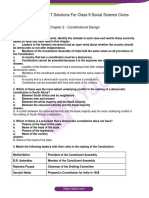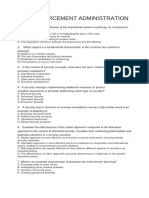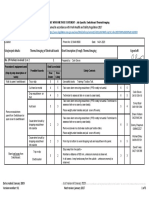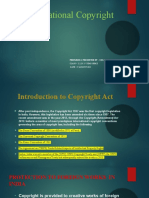0 ratings0% found this document useful (0 votes)
5 viewsCA Semis
CA Semis
Uploaded by
David john BernalCopyright:
© All Rights Reserved
Available Formats
Download as PPTX, PDF, TXT or read online from Scribd
CA Semis
CA Semis
Uploaded by
David john Bernal0 ratings0% found this document useful (0 votes)
5 views41 pagesOriginal Title
CA-Semis
Copyright
© © All Rights Reserved
Available Formats
PPTX, PDF, TXT or read online from Scribd
Share this document
Did you find this document useful?
Is this content inappropriate?
Copyright:
© All Rights Reserved
Available Formats
Download as PPTX, PDF, TXT or read online from Scribd
Download as pptx, pdf, or txt
0 ratings0% found this document useful (0 votes)
5 views41 pagesCA Semis
CA Semis
Uploaded by
David john BernalCopyright:
© All Rights Reserved
Available Formats
Download as PPTX, PDF, TXT or read online from Scribd
Download as pptx, pdf, or txt
You are on page 1of 41
Parole is just like conditional
pardon. It refers to the
conditional release of a convict
PAROL from a correctional institution
after he serves a minimum term
E of his prison sentence. It does
not have the effect of
extinguishing the criminal
liability of the convict.
Parole is also described as a
method of selective releasing an
offender from institution prior to
completion of his maximum
sentence, subject to conditions
specified by paroling authority.
1. The government
extends the convicts a
Principles privilege by releasing
of Parole them from prison
before their full
sentence is served.
2. The government
enters a release
Principles contract with the
of Parole convicts in exchange
for their promise to
abide by certain
conditions.
3. Convicts who
violate the law or
Principles conditions of parole
of Parole can be returned to
prison to complete
their sentences.
4. The government
Principles retains control of
parolees until they are
of Parole dismissed from parole.
Refers to the institutional
record of an inmate which
consist of the mittimus or
commitment order issued by
the court after conviction, the
Carpeta prosecutor’s information and
the decision of the trial court
and appellate court, if any;
certificate of non-appeal,
certificate of detention, and
other pertinent documents of
the case.
Refers to the
Parole supervision/surveillance by
Supervision probation and parole
Officer of a parolee.
Release Document- refers to the
“Discharge on Parole” issued by
the Board of Pardons and Parole.
Captain Alexander Maconochie
- In 1840, he was appointed
governor of the notorious English
penal colony at Norfolk Island off
the coast of Australia.
- He initiated a “mark system”
where a convict could earn
freedom by hard work and good
behavior in the prison.
Captain Alexander Maconochie
- The earned marks could be used to purchased their
goods or a reduction in sentence. Prisoners had to
pass through a series of stages beginning with strict
imprisonment through conditional release to final
freedom. Movement through the stages was
dependent upon the number of marks accredited.
Sir Walter Crofton
- He believed the length of the sentence should not be
an arbitrary period of time but should be related to the
rehabilitation of the offender. After becoming the
administrator of the Irish Prison System in 1854,
Crofton initiated a system incorporating three classes of
servitude. Irish system permitted convicts to earn marks
to move from solitary confinement to a return to the
community on a conditional pardon
Zebulon Reed Brockway
- A Michigan penologist, is usually credited with
initiating indeterminate sentences and parole
release in the United States.
- He had the opportunity to pioneer into practice in
1876 when he was appointed superintendent of
Elmira Reformatory for youthful offender in New
York.
Zebulon Reed Brockway
- The major concepts underlying parole were in place
in the United States: (1) reduction in the sentence
of incarceration based on good behavior in prison;
(2) supervision of the parolee in the community:
and (3) indeterminate sentences. By 1901, twenty
states had parole statutes and by 1944, every
jurisdiction in the United States had some form of
parole release and indeterminate sentencing.
Person Qualified for Parole
A prisoner is qualified for parole once the
inmate had served the minimum sentence, less
GCTA earned, of his indeterminate prison
sentence the maximum period of which exceeds
one year.
Person Disqualified for Parole
a. Those convicted of offenses punished with
death penalty of life imprisonment.
b. Those convicted of treason, conspiracy or
proposal to commit treason or espionage
c. Those convicted of misprision treason,
rebellion, sedition, coup d’ etat.
Person Disqualified for Parole
d. Those convicted of conspiracy, mutiny on
the high seas or Philippine waters.
e. Those who are habitual delinquents.
f. Those who are escaped from confinement.
g. Those who having been granted conditional
pardon by the president of the Philippines
shall have violated any of the term thereof.
Person Disqualified for Parole
h. Those whose maximum term of
imprisonment does not exceed one year or
those definite sentence.
i. Those who are convicted of the laws on
terrorism, plunder and transnational crimes.
Eligibility for Review of a Parole Case:
1. Inmate is serving an indeterminate sentence
the maximum period of which exceeds one
year.
2. Inmate has served the minimum period of
the indeterminate sentence.
3. Inmate’s conviction is final and executory.
Consideration for the grant of parole:
1. Evidence that the petitioner will find
legitimate source of livelihood upon release.
2. Petitioner has a place to establish residence.
3. Availability of after-care services for old,
seriously ill or physically disabled petitioner.
Special Consideration for the grant of
parole:
1. Old age, provided the inmate is below 60
years of age when crime is committed.
2. Physically disability, provided that physical
disability is not present when the crime was
committed.
3. Serious illness duly certified by a government
physician.
Special Consideration for the grant of
parole:
1. Old age, provided the inmate is below 60 years of age
when crime is committed.
2. Physically disability, provided that physical disability is
not present when the crime was committed.
3. Serious illness duly certified by a government
physician.
4. Similar circumstances which show that the continued
imprisonment will be inhuman or will pose grave
danger to the life of the petitioner.
PROCEDUR
E
Review upon the petition or
motupropio: forms and
contents of the petition:
a. That the petitioner’s
ONE case is eligible for
review by the band.
b. That he is not
disqualified from being
granted parole.
Transmittal of Carpeta and
prison record by the Director
TWO of BuCor or warden at least
one month prior to the date
when his case shall be
eligible for review.
Publication of names of
prisoners being considered
for parole in a new paper of
general circulation of those
THREE convicted of heinous crimes
or those sentenced to
reclusion perpetua or life
imprisonment and whose
sentence has been commuted
for release on parole.
Notice to offended party or
his immediate relatives,
personally of by registered
mail and given by 30 days
FOUR from notice within which to
communicate their comment
to the board regarding the
contemplated grant of parole
to the prisoner.
Basic Guidelines for
the Grant of Parole
The Board may grant a prisoner parole
based on reports regarding the prisoner’s
work and conduct and on the study and
investigation by the board itself and its find
the following circumstances are:
1. the prisoner is fitted by his training for
release.
2. That there is reasonable probability that.
If released, he will live and remain in liberty
without violating the law.
3. that is release will not be incompatible
with welfare of the society.
Rules after
grant of Parole
1. Transfer of Residence- a parolee may not be
transfer from one place of residence
designated in his release document without the
prior written approval of the regional director
subject to confirmation of the board.
2. Outside Travel- the chief PPO may authorize
a parolee to travel outside his area operational
jurisdiction for a period of not more than 30
days. A travel for more than 30 days shall be
approved by the regional director.
3. Travel abroad or work abroad- any parolee
under active supervision or surveillance who has
no pending criminal case in any court may apply
for overseas work or travel abroad. However, such
application for travel abroad shall be approved by
the Administrator and confirmed by the board.
4. Death of the Parolee- if the parolee dies during
the parole supervision, the PPO sha immediately
transmit a certified true copy of the parolee’s
death certificate to the board recommending the
closing of the case:
NOTE: absence of death certificate of the parolee,
an affidavit narrating the circumstances of the fact of
the death from the barangay chairman or any
authorized officer or any immediate relative where
the parolee resided.
Reports to be
accomplished by the
Supervising PPO
1. Progress report- when a parolee commits
another offense during the period of his parole
supervision and the case filed against him has
not yet been decided by the court or on the
conduct of the parolee while under
supervision.
2. Infraction report- when the parolee has been
subsequently convicted of another crime.
3. Violation report- when the parolee commits any
violation of the terms and conditions appearing in
his Release Document or any serious deviation or
non-observance of the obligations set forth in the
parole supervision program.
4. Summary report- after the expiration of the
maximum sentence of a parolee, the PPO
concerned shall submit to the board, through the
chief probation and parole officer, a summary
report on his supervision of parole.
Termination of
Parole Supervision
• Certificate of Final release and
Discharge- upon the receipt of the
summary report, the Board shall, upon the
recommendation of the Chief Probation
And Parole officer that the parolee ha
substantially complied with all the
conditions of his release document, issue to
the parolee a certificate of final release and
discharge.
• Effect of Certificate of Final release and
Discharge- upon the issuance of certificate
of final release and discharge, the parolee
shall be finally released and discharge from
the conditions appearing in his release
document.
NOTE: The accessory penalties of the law
which have not been expressly remitted
therein shall subsist.
• Transmittal of certificate of final release and
discharge- the board shall forward a certified
true copy of final release and discharge to the
parolee, the court which imposed the sentence,
the PPO concerned, the BuCor, NBI, PNP and
the office of the President.
1. Petition, contents and endorsements
2. Time and form of application
3. Transmittal of carpeta and prison record
You might also like
- Revised Rules and Regulations of The Board of Pardons and ParoleDocument9 pagesRevised Rules and Regulations of The Board of Pardons and ParoleJovie Dacoycoy100% (1)
- Bayan Muna V Alberto Romulo GR. 159618 FEBRUARY 1, 2011: FactsDocument2 pagesBayan Muna V Alberto Romulo GR. 159618 FEBRUARY 1, 2011: FactsJOYCE CAMILLE RODRIGUEZNo ratings yet
- Non Institutional CA2 Online Class Day4Document7 pagesNon Institutional CA2 Online Class Day4kemerutNo ratings yet
- Final CoverageDocument6 pagesFinal CoverageMecedilla, Jolly Jules, A.No ratings yet
- Non-Institutional Correction LectureDocument6 pagesNon-Institutional Correction LectureJanbert Suarez100% (1)
- Lesson 6 - Considerations For The Grant of ParoleDocument17 pagesLesson 6 - Considerations For The Grant of ParoleCrisJane Erica PerezNo ratings yet
- ParoleDocument17 pagesParoleJent Denise DisepedaNo ratings yet
- C.A 2by AmagoDocument16 pagesC.A 2by AmagoJvnRodz P GmlmNo ratings yet
- ParoleDocument135 pagesParoleApril Mae Bgys100% (1)
- C. A. 2 Non InstitutionalDocument12 pagesC. A. 2 Non InstitutionalKristina RebatoNo ratings yet
- CA 101 Lecture 13Document40 pagesCA 101 Lecture 13Johnpatrick Dejesus100% (1)
- Module 2 ParoleDocument11 pagesModule 2 ParoleErn BarlisoNo ratings yet
- Ca PD 968Document255 pagesCa PD 968stephanieque25No ratings yet
- Non Institutional CorrectionsDocument15 pagesNon Institutional CorrectionsMaycelle Rose Panoy90% (10)
- Chapter 9 - ParoleDocument8 pagesChapter 9 - ParoleJenesis TekikoNo ratings yet
- Non Instituional CorrectionsDocument19 pagesNon Instituional CorrectionsKris AdrieNo ratings yet
- Ca 2rules On Parole 1Document16 pagesCa 2rules On Parole 1Harold Jeff LagutaoNo ratings yet
- Rules On Parole and PardonDocument12 pagesRules On Parole and PardonFrederick EboñaNo ratings yet
- Ca 2 - Non-Institutional CorrectionsDocument13 pagesCa 2 - Non-Institutional CorrectionsWena Mae Cristobal50% (2)
- Parole and PardonDocument9 pagesParole and PardonArby Reyes100% (1)
- Parole IiDocument52 pagesParole IiJoshua BacoloNo ratings yet
- Rules On Parole and PardonDocument26 pagesRules On Parole and PardonArmida Talaugon75% (4)
- Introduction To Criminology 6Document38 pagesIntroduction To Criminology 6Kenn BuenoNo ratings yet
- Non Institutional CorrectionsDocument35 pagesNon Institutional CorrectionsHilron Diokno100% (1)
- Implementing Rules and Regulation On Parole and PardonDocument12 pagesImplementing Rules and Regulation On Parole and PardonWena Mae CristobalNo ratings yet
- Ca2 PPT October 24,2022Document27 pagesCa2 PPT October 24,2022Markche AncajasNo ratings yet
- CA 102 PPT 6 Module 2Document84 pagesCA 102 PPT 6 Module 221-76631No ratings yet
- Chapter 2 The Board of Pardon and ParoleDocument15 pagesChapter 2 The Board of Pardon and ParoleDanielle AlbaNo ratings yet
- 02 - CLJ1 Week 14 Lesson ProperDocument5 pages02 - CLJ1 Week 14 Lesson ProperBerto TendoNo ratings yet
- CA 2 LN MidtermDocument9 pagesCA 2 LN MidtermGio OxinaNo ratings yet
- Rules On Parole and PardonDocument10 pagesRules On Parole and Pardonenan_intonNo ratings yet
- Manual, SistozaDocument46 pagesManual, SistozalonitsuafNo ratings yet
- Parole and FurloughDocument5 pagesParole and FurloughRushi BhagatNo ratings yet
- Cad102 Midterm 1Document7 pagesCad102 Midterm 1Angel joergeNo ratings yet
- Ca 101 - Module 6Document8 pagesCa 101 - Module 6Shenai F. JuanceNo ratings yet
- Ca 101 - Module 6Document8 pagesCa 101 - Module 6Shenai F. JuanceNo ratings yet
- Cad Group 1Document4 pagesCad Group 1Mark Paul TumbaliNo ratings yet
- Chapter 5 Executive ClemencyDocument11 pagesChapter 5 Executive Clemencycooljoker1234No ratings yet
- Non Institutional CorrectionsDocument190 pagesNon Institutional CorrectionsLodi Disaster67% (6)
- Non Institutional Correction ReviewerDocument3 pagesNon Institutional Correction ReviewerDonnie Ray SolonNo ratings yet
- Correctional AdministrationDocument37 pagesCorrectional AdministrationEstonilo J. GarryboyNo ratings yet
- Parole: Ca 2 - Non-Institutional CorrectionsDocument8 pagesParole: Ca 2 - Non-Institutional CorrectionsWena Mae Cristobal100% (6)
- Reviewer in CA2 - Prelim 1Document6 pagesReviewer in CA2 - Prelim 1Calvinderwin MatanguihanNo ratings yet
- CoradDocument9 pagesCoradHanna DeoricNo ratings yet
- ParoleDocument2 pagesParoleThea Thei Ya100% (1)
- Non Institutional and Institutional CorrectionsDocument27 pagesNon Institutional and Institutional CorrectionsJoy Lorraine ViterboNo ratings yet
- 2 - ParoleDocument5 pages2 - ParolercangelopalomamagaNo ratings yet
- Board of Pardons and ParoleDocument8 pagesBoard of Pardons and ParoleTroy Henderson100% (1)
- Chapter 3Document7 pagesChapter 3Ranmar Ngaya-anNo ratings yet
- 80355-2000-Bureau of Corrections Operating ManualDocument55 pages80355-2000-Bureau of Corrections Operating ManualEugene UCNo ratings yet
- CA1 NewDocument18 pagesCA1 NewddaiselynNo ratings yet
- Correction NotesDocument7 pagesCorrection NotesKym Ralph CarnableNo ratings yet
- 2 - ParoleDocument6 pages2 - Paroleenemecio eliNo ratings yet
- Correction: Prison ManagementDocument8 pagesCorrection: Prison ManagementEmmanuel BuanNo ratings yet
- Southway College of Technology Criminology Department: Notes in Non-Instituional Corrections For Online ClassDocument45 pagesSouthway College of Technology Criminology Department: Notes in Non-Instituional Corrections For Online ClassAmber EbayaNo ratings yet
- Correction Chapter 1Document34 pagesCorrection Chapter 1Kym Ralph CarnableNo ratings yet
- ParoleDocument21 pagesParoleJhon Klinton Ani EscoroNo ratings yet
- Ca 2 WK10Document6 pagesCa 2 WK10Maria Frances MadrilejosNo ratings yet
- Lord Kayo Na Po Ang Bahala MwaDocument543 pagesLord Kayo Na Po Ang Bahala MwaSamsia Caoile AmerolNo ratings yet
- American Convention on Human Rights (Pact of San José)From EverandAmerican Convention on Human Rights (Pact of San José)No ratings yet
- TWG and or Minutes Aug 9, 2023Document3 pagesTWG and or Minutes Aug 9, 2023PPSMU PAMPANGA PPO100% (1)
- NCERT Solutions For Class 9 Social Science Civics: Chapter 2 - Constitutional DesignDocument3 pagesNCERT Solutions For Class 9 Social Science Civics: Chapter 2 - Constitutional DesignSaee Phadke Roll No-8 class-8bNo ratings yet
- G.R. No. 164457 Patula vs. PeopleDocument7 pagesG.R. No. 164457 Patula vs. PeopleAdrianNo ratings yet
- Prelims - MCQ (2.B) - Santiago, Irish Joy AcdDocument10 pagesPrelims - MCQ (2.B) - Santiago, Irish Joy AcdSeo NagiNo ratings yet
- Chapter 2 Nature and Effect of ObligationsDocument13 pagesChapter 2 Nature and Effect of Obligationskissle CyNo ratings yet
- Ipr Firms in Kolkata: S.No Firm Name Partners EmailDocument3 pagesIpr Firms in Kolkata: S.No Firm Name Partners EmailAditya MishraNo ratings yet
- Law Enforcement AdministrationDocument13 pagesLaw Enforcement AdministrationCess Ann BartzNo ratings yet
- Criminal Jurisdiction of Trial CourtsDocument1 pageCriminal Jurisdiction of Trial CourtsVILLARIN ANGELA M.No ratings yet
- Trenas vs. PeopleDocument16 pagesTrenas vs. PeopleAmmie AsturiasNo ratings yet
- Perlanggaran Tugas Utk Berhati-HatiDocument57 pagesPerlanggaran Tugas Utk Berhati-HatiNur AdlinaNo ratings yet
- Death Penalty Judgements Since 2017Document21 pagesDeath Penalty Judgements Since 2017Kumar AskandNo ratings yet
- Art 19 (1) (A) and 19 (2) PPT For StudentsDocument32 pagesArt 19 (1) (A) and 19 (2) PPT For StudentsParam ChaudharyNo ratings yet
- DRR Quarter 4 Week 3Document4 pagesDRR Quarter 4 Week 3Shastine ClaorNo ratings yet
- Sample of Affidavit of Arresting OfficersDocument2 pagesSample of Affidavit of Arresting OfficersLeza FurCasNo ratings yet
- Parole Application DraftDocument3 pagesParole Application DraftJojo NavarroNo ratings yet
- Professional Ethics QuestionDocument2 pagesProfessional Ethics QuestionShashi Sharma RijalNo ratings yet
- Infrascan SwmsDocument5 pagesInfrascan Swmsapi-271287158No ratings yet
- Children Act 2020Document80 pagesChildren Act 2020nandapoinapenNo ratings yet
- Bdau2103 Final ExamDocument15 pagesBdau2103 Final ExamAIMAN ISKANDAR BIN AZMAN SHAH STUDENTNo ratings yet
- International CopyrightDocument22 pagesInternational CopyrightKedar KulkarniNo ratings yet
- LikewiseDocument2 pagesLikewiseMouni JayaramanNo ratings yet
- Probate 1Document8 pagesProbate 1Beatrice MatamaNo ratings yet
- Sentencing Case On Not Considering Time Spent in Custody On 2nd Charge When Being Sentenced On A Different ChargeDocument29 pagesSentencing Case On Not Considering Time Spent in Custody On 2nd Charge When Being Sentenced On A Different ChargeKirby JoNo ratings yet
- PPG ReportDocument29 pagesPPG Reportannbasical672No ratings yet
- Social Contract Under MarcosDocument5 pagesSocial Contract Under MarcosAKIRA DokkabeiNo ratings yet
- CCTV PolicyDocument7 pagesCCTV Policysharon Aisha malroyNo ratings yet
- The Anatomy of Torture A Documentary History of Filartiga v. Pena-Irala (William J. Aceves) (Z-Library)Document818 pagesThe Anatomy of Torture A Documentary History of Filartiga v. Pena-Irala (William J. Aceves) (Z-Library)e1224364860748496No ratings yet
- Ashworth (1989) PDFDocument21 pagesAshworth (1989) PDFjamie.morris.2024No ratings yet
- Ganzon Vs CADocument4 pagesGanzon Vs CAJoseph Anthony BrizNo ratings yet

























































































